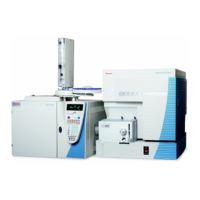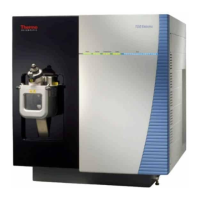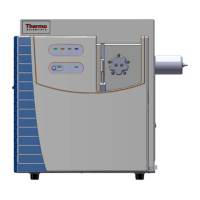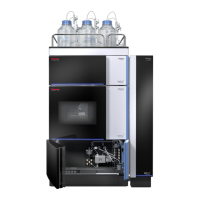2
Functional Description
Mass Spectrometer
42 TSQ Series Hardware Manual Thermo Scientific
Ions enter the Q2 collision cell, collide with the argon collision gas, and then, because of the
collision, dissociate into smaller fragments. See “Collision Cell and CID Efficiency” on
page 32.
Argon (135 ± 70 kPa [20 ± 10 psi], 99.995% minimum purity) enters the mass spectrometer
through a 1/8-in. port on the left side of the mass spectrometer. See Figure 32.
A second proportional valve allows the forepump to evacuate the Q2 collision cell of argon
and waste gases when CID is turned off. The TSQ mass spectrometer automatically opens
and closes the collision gas evacuation valve, depending on whether Q2 is acting as an ion
transmission device or a collision cell.
Sheath Gas Valve
The sheath gas valve controls the flow of sheath gas (nitrogen) into the API source. Dry
nitrogen (690 ± 140 kPa [100 ± 20 psi], 99% purity) enters the mass spectrometer through a
1/4 in. port on the left side of the mass spectrometer. See Figure 32. A solenoid shutoff valve
starts and stops the flow of nitrogen to the API source. The data system controls a valve that
regulates the sheath gas pressure. You can set the sheath gas flow rate (0 to 100 in arbitrary
units) in the Ion Source dialog box from the EZ Tune window. The sheath gas enters the API
source through 1/8 in. ID tubing.
Auxiliary Gas Valve
The auxiliary gas valve controls the flow of auxiliary gas (nitrogen) into the API source. Dry
nitrogen (690 ± 140 kPa [100 ± 20 psi], 99% purity) enters the mass spectrometer through a
1/4 in. port on the left side of the mass spectrometer. A solenoid shutoff valve starts and stops
the flow of nitrogen to the API source. The auxiliary gas pressure is regulated by a flow valve
that is controlled by the data system. You can set the auxiliary gas flow rate (0 to 60 in
arbitrary units) in the Ion Source dialog box. The auxiliary gas enters the API source through
1/8 in. ID tubing.
Figure 32. Nitrogen and argon gas inlets
Nitrogen In
690 ± 140 kPa
(100 ± 20 psi)
Nitrogen for
Vent
35 kPa MAX
(5 psi MAX)
Argon In
135 ± 70 kPa
(20 ± 10 psi)

